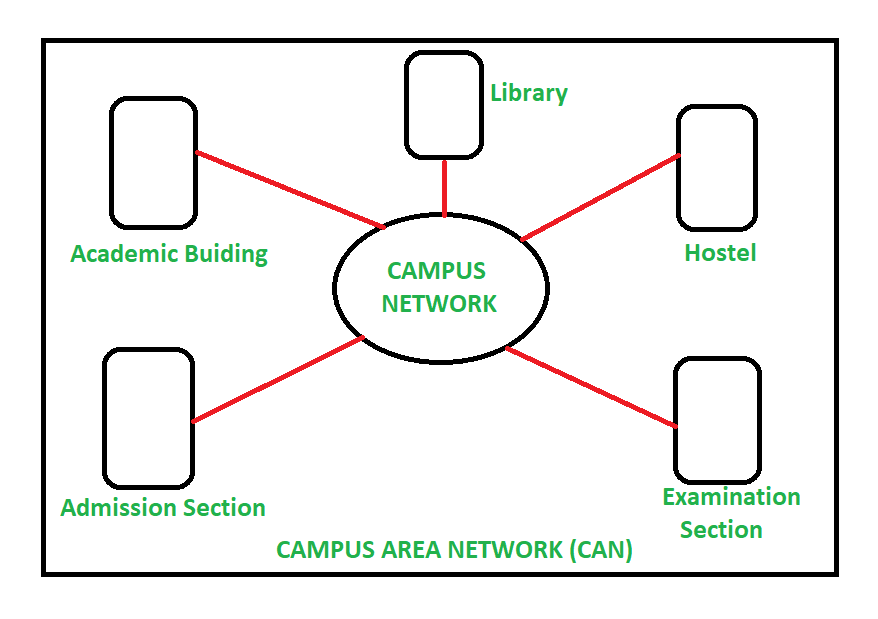Difference between CAN and WAN
Last Updated :
18 Mar, 2023
Introduction:
A Campus Area Network (CAN) is a type of network that connects multiple Local Area Networks (LANs) within a specific geographic area, such as a university campus or a large business park. On the other hand, a Wide Area Network (WAN) is a type of network that spans a large geographic area and connects devices that are located in different cities, states, or countries.
Campus Area Network (CAN) is a group of interconnected Local Area Networks (LAN) within a limited geographical area like school campus, university campus, military bases, or organizational campuses and corporate buildings etc. A Campus Area Network is larger than Local Area Network but smaller than Metropolitan Area Network (MAN) and Wide Area Network (WAN). 
Advantages of CAN:
- High reliability: CAN networks are highly reliable due to their robust design and error detection capabilities.
- Real-time communication: CAN networks are designed for real-time communication, making them ideal for applications that require quick response times.
- Cost-effective: CAN networks are cost-effective to implement and maintain, making them ideal for applications that require a large number of nodes.
- Scalable: CAN networks can be easily expanded by adding nodes or by integrating with other networks.
Disadvantages of CAN:
- Limited speed: CAN networks have a limited data transfer speed, making them unsuitable for applications that require high-speed data transfer.
- Limited range: CAN networks have a limited range, typically limited to a single vehicle or machine.
- Limited bandwidth: CAN networks have a limited bandwidth, which can limit the amount of data that can be transmitted at any given time.
- Limited application: CAN networks are specifically designed for automotive and industrial applications and may not be suitable for other applications.
WAN covers the large area than LAN as well as MAN such as: Country/Continent etc. WAN is expensive and should or might not be owned by one organization. PSTN or Satellite medium are used for wide area network. 
Advantages of WAN:
- Wide coverage: WANs cover a large geographical area, allowing users to connect over long distances.
- High-speed data transfer: WANs can support high-speed data transfer rates, making them suitable for transferring large files and streaming media.
- Resource sharing: WANs allow users to share resources such as printers and storage devices, which can reduce costs and increase efficiency.
- Increased productivity: By enabling resource sharing and easy communication, WANs can increase productivity by making it easier for users to work together.
Disadvantages of WAN:
- Cost: Setting up and maintaining a WAN can be expensive, especially if it requires specialized hardware and software.
- Security concerns: WANs can be vulnerable to security breaches if proper security measures are not in place.
- Complexity: WANs are complex networks that require skilled IT professionals to design and maintain.
- Dependence on service providers: WANs depend on service providers for connectivity, which can lead to downtime if the service is disrupted.
Similarities between CAN and WAN networks:
- Network Devices: Both CAN and WAN networks use similar network devices, such as routers, switches, and hubs. These devices are used to connect devices within the network and manage the flow of data.
- Network Protocols: Both CAN and WAN networks use similar network protocols, such as TCP/IP and Ethernet, to ensure that devices can communicate with each other regardless of the type of network they are on.
- Network Administration: Both CAN and WAN networks require network administration to ensure that the network is running efficiently and effectively. Network administrators must manage and troubleshoot network issues, configure network devices, and ensure that the network is secure.
- Network Security: Both CAN and WAN networks require some level of security to protect data and prevent unauthorized access. Both types of networks may use firewalls, access control lists, and other security measures to protect the network.
- Data Transmission: Both CAN and WAN networks transmit data between devices, albeit over different distances and at different speeds. Both networks use data packets to transmit information between devices.
Difference between CAN and WAN :
| S.No. |
CAN |
WAN |
| 1. |
CAN stands for Campus Area Network. |
WAN stands for Wide Area Network. |
| 2. |
Connects two or more LANs within a campus. |
Connects geographically separated LANs. |
| 3. |
It covers a privately-owned campus with an area of 5 to 10 KM. |
Spans large geographical area more than 100 KM. |
| 4. |
The data transmission rate is variable. |
The data transmission rate is from 64Kbps to 150 Mbps. |
| 5. |
It is Expensive then LAN. |
It is Most Expensive. |
| 6. |
It doesn’t use the ITU standard. |
It Uses the ITU standard. |
| 7. |
The networking devices such as a hub, switch, Bridge, and gateway are used. |
The networking devices such as a hub, switch, Bridge, and gateway are used. |
| 8. |
It contains Less congestion compare WAN. |
It contains Most congestion network compared to CAN. |
Introduction:
While both CAN and WAN networks are used to connect multiple devices together, they have different applications and characteristics. CAN networks are generally used to connect LANs within a specific geographic area, while WAN networks are used to connect devices that are located in different cities, states, or countries. Understanding these differences can help you determine which type of network is most appropriate for your needs.
Like Article
Suggest improvement
Share your thoughts in the comments
Please Login to comment...